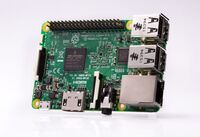Raspberry Pi 3 (raspberry-pi3)
Appearance
 | |
| Manufacturer | Raspberry Pi Foundation |
|---|---|
| Name | Raspberry Pi 3 |
| Codename | raspberry-pi3 |
| Released | 2013-2018 |
| Hardware | |
| Chipset | Broadcom BCM2837 |
| CPU | 4x 1.4 Ghz Cortex-A53 |
| GPU | Broadcom VideoCore IV |
| Display | HDMI port |
| Storage | MicroSDHC slot |
| Memory | 1024 MB |
| Architecture | aarch64 |
| Software | |
| Original software | Raspbian |
| postmarketOS | |
| Category | testing |
| Pre-built images | no |
| Mainline | yes |
| Unixbench Whet/Dhry score | 513.9 |
| Internal storage |
No data |
|---|---|
| SD card |
No data |
| Screen |
Works |
| Multimedia | |
| 3D Acceleration |
Works |
| Audio |
Works |
| Camera Flash |
No data |
| Connectivity | |
| WiFi |
Works |
| Bluetooth |
Works |
| NFC |
No data |
| Miscellaneous | |
| FDE |
Works |
| USB OTG |
No data |
| HDMI/DP |
No data |
| Sensors | |
| Magnetometer |
No data |
| Ambient Light |
No data |
| Proximity |
No data |
| Hall Effect |
No data |
| Haptics |
No data |
| Barometer |
No data |
Contributors
Installation
1. Follow the steps on Installation_guide#Initialization
2. Choose the raspberry-pi3 device
3. Start the build process and install the completed image to a sdcard
$ ./pmbootstrap.py install --sdcard /dev/sdX
(replace /dev/sdX with the device for your sdcard)
4. Place the sdcard into the Raspberry Pi and boot it
Features
Audio
The audio is configured to be sent to the HDMI port by default.
If you want to use the onboard jack you have to run this command:
$ amixer cset numid=3 1
(test the output with)
$ speaker-test -c 2
(change output back to HDMI)
$ amixer cset numid=3 2
Photos
-
XFCE4
-
XFCE4
See also
- The Raspberry Pi has a pre-existing port of Alpine Linux
- It should be possible to convert the pre-existing RPi Alpine install to a pmOS install.
- #1137 Testing out Hildon and XFCE4 (other UIs did not work at all?) on Raspberry Pi after converting the Alpine installation
- rpi-open-firmware - a Free Software firmware for the Pi.
- #1501 initial PR
- pmaports!125 New device: Raspberry Pi Zero with Ethernet over USB enabled

